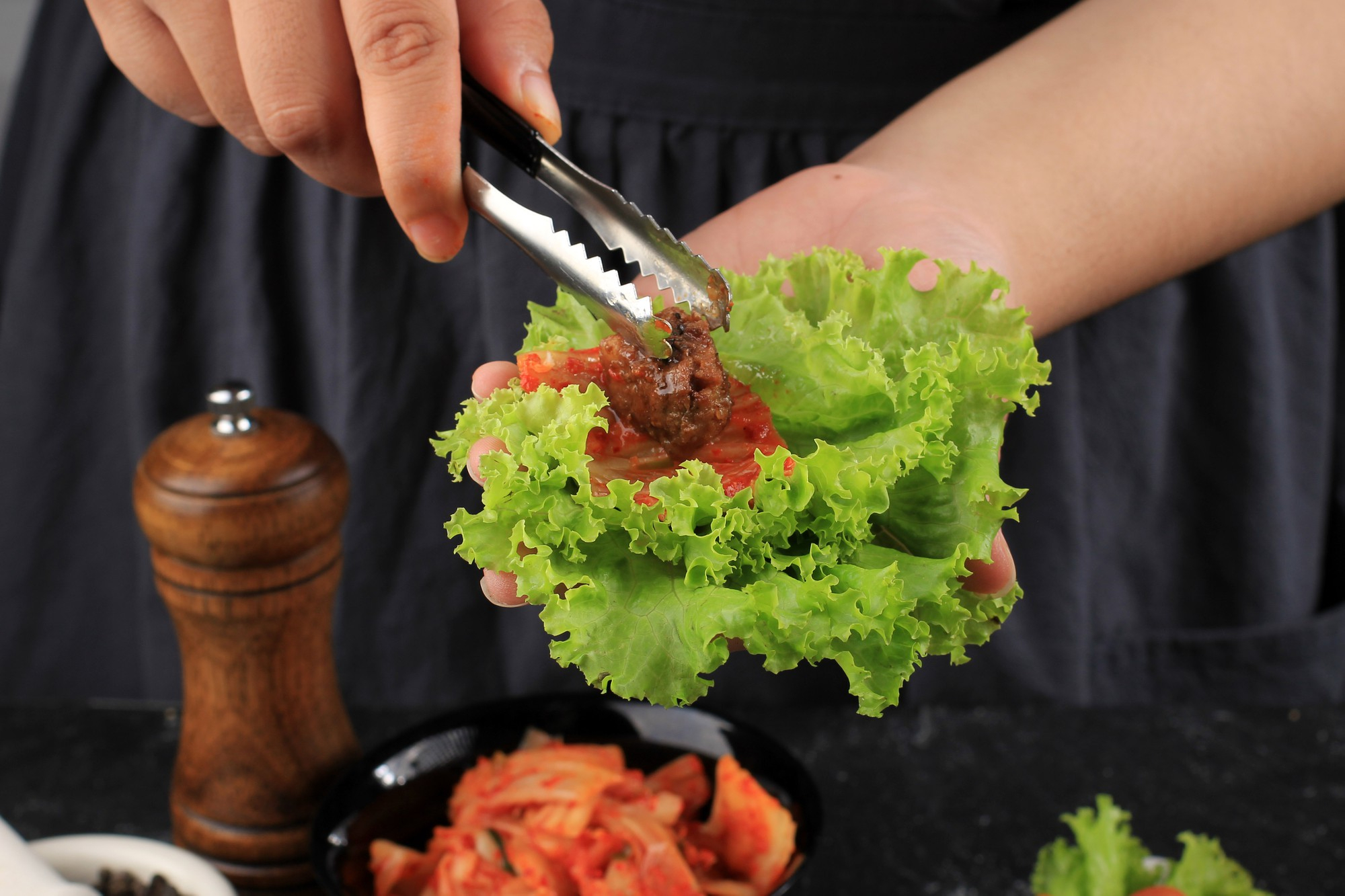Bossam is a classic Korean meal prepared with boiling pork and other flavorful ingredients such as onion, garlic, ginger and green onion etc. The meat is then thinly sliced after being boiled until it is completely done and tender.
Most often, it is served with lettuce or napa cabbage leaves, some hot dipping sauce, and fresh, crisp kimchi. Bossam can be consumed whenever you’re in the mood for a rich, meaty feast. However, there is one time of year in Korea when we always, always eat bossam: at the start of winter, immediately following the completion of our yearly kimchi-making cycle. This custom is known as gimjang and requires a lot of time and effort.
Bossam and the Making of Kimchi
The first step involves chopping, brining and rinsing of cabbage heads (usually when my mom does this, she works with hundreds of cabbage heads). On day two, we then shred hundreds of mu radishes (Korean radishes) and combine tons of chili powder, fish sauce, garlic, and other ingredients before spreading this “stuffing,” known as sok, onto each and every leaf (this is usually done by me, my siblings and my grandma). Consequently, gimjang is frequently a neighborhood gathering. There’s no way one person could complete all that work alone, so you have to help each other.
How to Make Bossam
The raw pig belly is first rinsed before being lightly blanched in boiling water. Blanching options include either plain water or the rice-rinse water, which is treasured in Korea for the flavorful subtlety it imparts to meals.
The pork is then simmered in a poaching liquid that has already been flavored with alliums like scallion, garlic, and onion as well as bay leaf, cinnamon, ginger, and doenjang (Korean fermented soybean paste). To further mask and eliminate any overt porky flavors, some people even add instant coffee to the water. (If you’re making gimjang, you’ll likely already have many, if not all, of the components for the poaching process on hand; since you’re already putting a lot of effort into the kimchi. We also place a lot of value on color, so if you want your meat to appear a little darker, add extra doenjang to the pan and leave the onion skins on. The instant coffee I stated earlier also contributes to the pork’s color.
Once the meat is done and fork-tender, allow it to cool in the cooking liquid before slicing the meat. This ensures that the pork to remains moist. If you don’t have much time, let the cooked meat cool under cold running water before slicing.
Ingredients
For the Cabbage:
- Salt
- Tender inner part from 1/2 head Napa
For the Pork:
- 680g slab pork belly, preferably skin-on
- Rice-rinsing water (optional)
- 3 tablespoons doenjang (Korean fermented soybean paste)
- 1 whole medium yellow onion
- 10 scallions
- 1/2 medium-size apple
- 1 thumb-size knob fresh ginger, peeled
- 1 piece cinnamon stick
- 10 medium-size garlic cloves
- 1 teaspoon whole black peppercorns (about 15)
- 1 small bay leaf
- 1/4 cup soju or vodka
For the Saewoo Jeot Seasoning:
- 1/2 tablespoon saewoo jeot (Korean salted shrimp)
- 1/2 tablespoon soju or vodka
- Pinch gochugaru (Korean chili flakes)
- Pinch minced Korean green chili pepper (optional)
For the Ssamjang:
- 1 tablespoon doenjang (Korean fermented soy paste)
- 1 tablespoon gochujang (Korean chili paste)
- 1/2 teaspoon crushed roasted sesame seeds
- 1 medium-size clove garlic, minced
- 1/8 teaspoon toasted sesame oil
For Serving:
- One small container mu malaengi muchim (chili-sauce seasoned rehydrated radish)
- Thinly sliced garlic
- Thinly sliced fresh Korean green chili (optional)
Directions
- To prepare a 3% brine for the cabbage, dissolve 3 grams of salt in 100 grams of water, or about 3 tablespoons of Diamond Crystal kosher salt in 1 quart of water. Place cabbage leaves in brine and cover with a plate to keep them immersed. Let the cabbage leaves soak for a minimum of three hours and a maximum of eight hours. Drain, then set aside.
- For the pork: Under cold running water, thoroughly wash the pork belly. Fill a pot big enough to contain the slab of pork belly with enough plain water or rice-rinsing water to completely cover it and heat to a rolling boil. Cook for 5 minutes after adding the pork belly and bringing the mixture back to a boil. Drain.
- Clean the pot, then add an equal volume of new water. Add the doenjang, onion, scallions, apple, ginger, cinnamon, garlic, peppercorns, and bay leaf. Boil over high heat.
- Boil the pork for 20 minutes with the lid on. Uncover pot, turn heat to medium-low, and stir in soju. Cook the pork for an additional 40 minutes or until it can be easily penetrated with a fork.
- Fill a big bowl halfway with ice water. Remove the pork from the cooking liquid with care and run it under cold running water for a few seconds before transferring to ice water to cool the outside of the pork. Allow for a 5-minute rest.
- Meanwhile, make the Saewoo Jeot Seasoning by combining saewoo jeot and soju in a small bowl. If you wish, season with gochugaru, crushed roasted sesame seeds, and/or minced green chili.
- To make the Ssamjang, combine doenjang, gochujang, crushed roasted sesame seeds, minced garlic, and sesame oil in a small bowl.
- Slice the pork thinly before serving. Put the sliced pork, drained cabbage leaves, and mu malaengi muchim on a dish. Place the ssamjang, saewoo jeot, sliced garlic, and green chilies on serving plates.
- To eat, dip a piece of pork in the saewoo jeot and place it on a cabbage leaf. Add a portion of garlic, a dollop of ssamjang, and a few pieces of mu malaengi; if desired, garnish with a slice of green chile. Wrap the cabbage around everything and eat it all at once.
